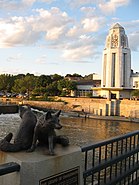
Kane County is a county in the U.S. state of Illinois. According to the 2020 census, it has a population of 516,522, making it the fifth-most populous county in Illinois. Its county seat is Geneva, and its largest city is Aurora. Kane County is one of the collar counties of the metropolitan statistical area designated "Chicago–Naperville–Elgin, IL–IN–WI" by the US census.

Elgin is a city in Cook and Kane counties in the U.S. state of Illinois. It is located 35 mi (56 km) northwest of Chicago along the Fox River. As of the 2020 census, the city had a population of 114,797, making it the sixth-most populous city in the state.

Aurora is a city in northeastern Illinois, United States, located along the Fox River. The population was 180,542 at the 2020 census. It is the second-most populous city in Illinois, after Chicago, and the 144th-most populous city in the US. Aurora is the largest city in Illinois that is not the county seat of any county that it resides in.

Batavia is a city mainly in Kane County and partly in DuPage County in the U.S. state of Illinois. Located in the Chicago metropolitan area, it was founded in 1833 and is the oldest city in Kane County. Per the 2020 census, the population was 26,098.

Elburn is a village in Kane County, Illinois, United States. The population was 5,602 as of the 2010 census, up from 2,756 at the 2000 census. It is located at the intersection of Illinois Route 38 and Route 47. Elburn is a town situated 46 miles (74 km) west of the Chicago Loop with frequent commuter rail service from its Metra station at the end of the Union Pacific West Line.

North Aurora is a village in Kane County, Illinois, United States, and a suburb of Aurora. Per the 2020 census, the population was 18,261. North Aurora maintains its own public library district, fire district, and police department, but public spaces and parks are managed by the neighboring Fox Valley Park District.
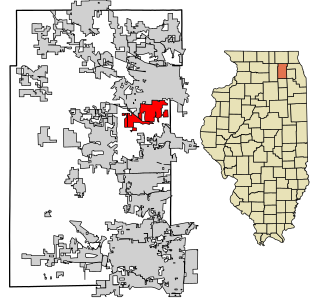
South Elgin is a village in Kane County, Illinois, United States. Per the 2020 census, the population was 23,865. In 2007, Money magazine named South Elgin as 82nd of 100 entries in its "America's Best Places to Live" edition and again in 2011 as 98th of 100 entries.

Area codes 630 and 331 are telephone area codes in the North American Numbering Plan (NANP) for portions of Chicago's near and far western suburbs, including the majority of DuPage County, Illinois. To the northwest, the numbering plan area (NPA) also includes a small portion of Cook County, including parts of Schaumburg, Streamwood and Hanover Park. To the west, Kane County is divided between area codes 847 and 224 in the north, including Elgin, and area codes 630 and 331 in the south, including Aurora. To the south, the northern part of Will County and a small part of southern Cook County, including the village of Burr Ridge and parts of the village of Lemont, are also included in the 630 and 331 area codes. To the southwest, the city of Yorkville, in exurban Kendall County, is included, as well.

The Upstate Eight Conference is an organization of fourteen high schools in northeastern Illinois, representing ten communities in Chicago's suburbs. These high schools are all members of the Illinois High School Association.
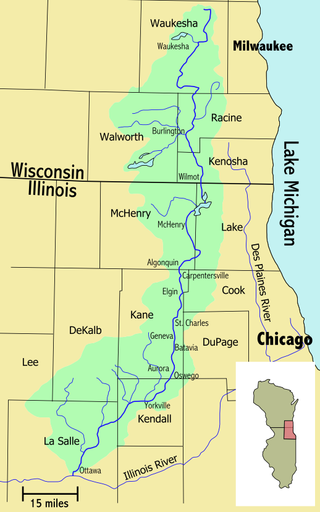
The Fox Valley—also commonly known as the Fox River Valley—is a region centered on the Fox River of Northern Illinois, along the western edges of the Chicago metropolitan area. The region extends from the village of Antioch, in far northern Illinois, to the city of Ottawa in the south. It includes rural areas, suburban development, and 19th-century downtowns. Around 1 million people live in this area.

The Chicago Aurora and Elgin Railroad (CA&E), known colloquially as the "Roarin' Elgin" or the "Great Third Rail", was an interurban railroad that operated passenger and freight service on its line between Chicago and Aurora, Batavia, Geneva, St. Charles, and Elgin, Illinois. The railroad also operated a small branch to Mt. Carmel Cemetery in Hillside and owned a branch line to Westchester.
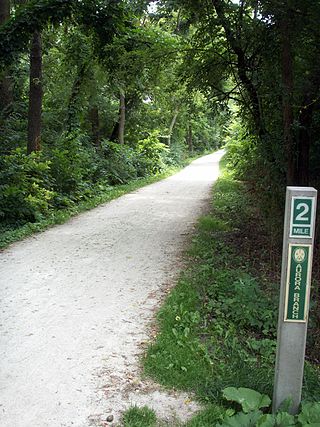
The Illinois Prairie Path is a network of 61 miles (98 km) of bicycle trails, mostly in DuPage County, Illinois. Portions of the trail extend west to Kane County and east to Cook County. Most of the trail is categorized as rail-to-trail, meaning that the bicycle path is built atop a converted former railroad right of way. In the case of the Prairie Path, the vast majority of its routing runs on the former right-of-way of the Chicago Aurora and Elgin Railroad.
Randall Road is a major north-south stroad and county highway in McHenry and Kane County, Illinois. The road is named after Norman Randall, a prominent area landowner in the 1930s. It serves as the western extent of the Fox Valley suburbs in the Chicago metropolitan area. Its southern terminus is in Aurora, Illinois, at Marseillaise Place. Its northern terminus is at a full four-way intersection at McHenry Avenue and James R. Rakow Road in Crystal Lake, Illinois. The road is 31.4 mi (50.5 km) in length.

The Illinois Technology and Research Corridor is a region of commerce and industry located along Interstate 88 in the Chicago metropolitan area, primarily in Cook, DuPage, Kane, and DeKalb Counties. The corridor is home to the headquarters or regional centers for many Fortune 1000 companies, several office and industrial parks, colleges and universities, research and scientific institutions, medical centers, government centers, and abundant shopping, dining, lodging, and entertainment amenities. In addition to the I-90 Golden Corridor, the I-94 Lakeshore Corridor, and the I-55 Industrial Corridor, the Illinois Technology and Research Corridor is one of the principal economic centers in suburban Chicago.

Geneva is a city in and the county seat of Kane County, Illinois, United States. It is located in the far western side of the Chicago suburbs. Per the 2020 census, the population was 21,393.

The 11th congressional district of Illinois is represented by Democrat Bill Foster.

Winfield Township is one of nine townships in DuPage County, Illinois, USA. As of the 2020 census, its population was 45,836 and it contained 16,445 housing units. It is the least populous of the DuPage County Townships.

The Aurora, Elgin & Fox River Electric (AE&FRE), was an interurban railroad that operated freight and passenger service on its line paralleling the Fox River. It served the communities of Carpentersville, Dundee, Elgin, South Elgin, St. Charles, Geneva, Batavia, North Aurora, Aurora, Montgomery, and Yorkville in Illinois. It also operated local streetcar lines in both Aurora and Elgin.

St. Charles is a city in DuPage and Kane counties in the U.S. state of Illinois. It lies roughly 40 miles (64 km) west of Chicago on Illinois Route 64. Per the 2020 census, the population was 33,081. The official city slogan is "Pride of the Fox", after the Fox River that runs through the center of town. St. Charles is part of a tri-city area along with Geneva and Batavia, all western suburbs of similar size and socioeconomic condition.
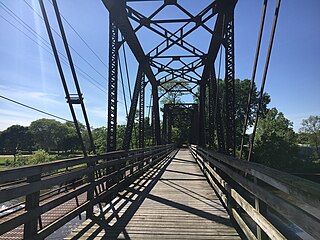
The Fox River Trail is a multi-use path in Illinois along the Fox River. Largely in Kane County, the trail connects the communities of Algonquin, Carpentersville, Dundee, Elgin, South Elgin, St. Charles, Geneva, Batavia, North Aurora, Aurora, Montgomery, and Oswego.





